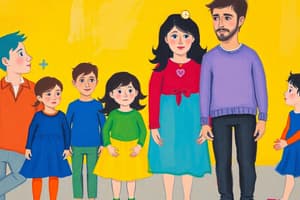Podcast
Questions and Answers
The social responsibility model emphasizes the importance of the family unit over individual well-being.
The social responsibility model emphasizes the importance of the family unit over individual well-being.
False (B)
The Québec Parental Insurance Plan (QPIP) is available for families outside of Québec.
The Québec Parental Insurance Plan (QPIP) is available for families outside of Québec.
False (B)
Approximately 60% of children are in daycare while 75% are not in regulated daycare programs.
Approximately 60% of children are in daycare while 75% are not in regulated daycare programs.
True (A)
Low-income families receive higher parental leave benefits than middle-class families.
Low-income families receive higher parental leave benefits than middle-class families.
The parental leave program in Quebec has improved access for 30% of mothers who were previously not eligible for support.
The parental leave program in Quebec has improved access for 30% of mothers who were previously not eligible for support.
The fertility rate in Canada has been above 2 children per couple since the 1970s.
The fertility rate in Canada has been above 2 children per couple since the 1970s.
Women in Canada have the lowest total work burden among G7 countries.
Women in Canada have the lowest total work burden among G7 countries.
The percentage of married couples in Canada has increased over the past several decades.
The percentage of married couples in Canada has increased over the past several decades.
Over 35% of mothers with young children in Canada work full-time.
Over 35% of mothers with young children in Canada work full-time.
The individual responsibility model promotes a traditional view of gender roles.
The individual responsibility model promotes a traditional view of gender roles.
Canadian same-sex couples with children increased by 1 in 8 in 2016.
Canadian same-sex couples with children increased by 1 in 8 in 2016.
The Vanier Institute of the Family focuses on promoting policies that support family diversity.
The Vanier Institute of the Family focuses on promoting policies that support family diversity.
Lone-parent families make up roughly 30% of all families in Canada.
Lone-parent families make up roughly 30% of all families in Canada.
Over 80% of COVID-19 deaths occurred in long-term care facilities.
Over 80% of COVID-19 deaths occurred in long-term care facilities.
Canada spends more on family benefits than most OECD countries.
Canada spends more on family benefits than most OECD countries.
The Family Allowance Act was introduced during World War II.
The Family Allowance Act was introduced during World War II.
Income splitting allows couples to transfer up to $50,000 in earned income between spouses.
Income splitting allows couples to transfer up to $50,000 in earned income between spouses.
Almost 25% of seniors aged 65 and older are caregivers themselves.
Almost 25% of seniors aged 65 and older are caregivers themselves.
Women are primarily concentrated in high-paying occupations.
Women are primarily concentrated in high-paying occupations.
The COVID-19 crisis did not affect gender disparities significantly.
The COVID-19 crisis did not affect gender disparities significantly.
Government budgets historically have been developed in a gender-sensitive manner.
Government budgets historically have been developed in a gender-sensitive manner.
Study Notes
Canadian Families Today
- Canadian families have undergone significant changes in the past 50 years.
- Existing policies supporting families are outdated.
- Policies focusing on childcare, parental leave, caregiver support, and gender income equality are necessary to support contemporary family structures.
Dual-Earning Families
- Dual-earning families are the norm in Canada.
- Women's participation in the workforce has increased.
- Canadian women have the highest total work burden among G7 countries.
Women's Employment
- Over 3.6 million more women are in the workforce compared to forty years ago.
- Mothers of young children are more likely to work, with over 35% working full-time.
- Women are not paid equally to men and perform more unpaid work at home.
Population Replacement Rate
- Fewer children are being born, contributing to a decline in the population replacement rate.
- Fertility rate has been below 2 children per couple since the 1970s.
Vanier Institute of the Family
- This national, independent, charitable organization focuses on family diversity and complexity.
- The Institute promotes better family policies in Canada.
- It defines families as two or more individuals bound by mutual consent, birth, adoption, or placement of children/family members.
- Responsibilities of families include: physical maintenance, addition, socialization, social control, production, consumption, distribution of goods and services, and affective nurturance of children/family members.
Changing Family Structures
- Married couples still dominate (65.8%) but are decreasing.
- In 2016, 21.3% of couples lived common law, a three-fold increase since 1981.
- Lone-parent families increased to 16.4%, with 8 out of 10 led by women.
- Same-sex couples: 72,880 couples in 2016, with one-third married and one in eight having children.
- Households with 5 or more people decreased from 1941 to 2016, while households with 1 or 2 people increased.
- Affordable childcare is linked to higher fertility rates and greater women's labor force participation.
Models of the Family
The Patriarchal Model
- This model has influenced income security policy, social programs, and family law.
- The wife/mother is held responsible for home care and services.
- The husband/father is responsible for earning income outside the home.
The Individual Responsibility Model
- Acknowledges formal gender equality.
- Promotes shared caregiving and gender-neutral language.
- Encourages gender participation in the labor market, including mothers.
The Social Responsibility Model
- Prioritizes individual well-being over the family unit.
- Treats every person as an individual, similar to the healthcare system.
Supporting Family Caregiving
- Long-term fertility decline poses challenges for family caregiving.
- Aging parents limit available support.
- Basic resources like time and money are often in short supply.
Childcare
- Two parental leave benefit programs exist for newborn or adopted children: a federal program for families outside Quebec and the Quebec Parental Insurance Plan (QPIP) for Quebec residents.
- Benefits of early childhood education and care programs often outweigh costs, especially for disadvantaged groups.
- 60% of children are in daycare, with only 75% in regulated daycare programs.
- Families select various childcare solutions.
Gaps in the Parental Leave System
- The Employment Insurance system manages maternity/parental leave benefits.
- One-third of parents are ineligible due to insufficient work hours.
- Low-income families receive lower benefits than middle-class families.
- The new parental leave program offers 5-8 weeks of extra paid leave for the second parent.
Quebec's Childcare Program
- Broadened access to maternity/parental leave benefits.
- Strengthened women's labor market participation.
- Increased family incomes.
- Less disparities compared to Canada's federal maternity/parental leave program.
- Improved access for 30% of mothers previously ineligible for support.
- Provides an estimated annual net gain of over $200 million for the province.
- Encourages parental leave under the right conditions.
- Offers lessons for Canadian policymakers on the importance of affordable and accessible childcare.
Caring for the Elderly
- The long-term care system was designed 50 years ago and needs updating.
- The COVID-19 pandemic highlighted the need for national standards of care and increased investment.
- Over 80% of COVID-19 deaths occurred in long-term care.
- Challenges include reliance on a subcontracted labor force and poor conditions in some care homes.
- Almost 25% of seniors aged 65 and older are caregivers themselves, leading to stress and strain.
- Friends and family spend up to 10 hours per week caring for the elderly.
Gender Disparities and COVID-19
- The crisis exacerbated existing gender disparities, particularly for those facing intersecting forms of discrimination.
- Women were at the forefront of the crisis, providing primary care and support, and comprising the majority of the frontline workforce.
- A gender-just recovery plan needs to focus on the needs and perspectives of women, girls, and gender-diverse individuals.
Family Benefits Overview
- Canada spends less than most OECD countries on family benefits.
- Benefits for widowed mothers were introduced during World War I.
- The Family Allowance Act was introduced post-World War II.
- Despite changes in program names and amounts, the principle of universal family support remains.
- Families receive tax exemptions, allowances, and deductions to reduce their personal income taxes.
Income Splitting
- The Conservative government introduced an income-splitting tax break for couples with children in 2011.
- This policy allowed married and common-law couples with children under 18 to transfer up to $50,000 in earned income from one spouse to the other.
- This policy was regressive, primarily benefiting families with a second parent and large income differences.
- It did not benefit lone-parent families or lower-income families who already benefited from other tax credits and deductions.
The Gender Gap
- Income-tested incentives for non-working parents in two-parent families have financial implications for the non-working parent and the country.
- Women are concentrated in low-paying occupations, industries, and establishments.
- Gender segregation accounts for a significant portion of the overall gender wage gap.
- New budgeting legislation mandates reporting on gender and diversity in taxation and resource allocation.
- Government budgets often impact men and women differently due to their different social and economic positions.
- Governments have historically developed policies and allocated funding in a gender-blind manner.
Studying That Suits You
Use AI to generate personalized quizzes and flashcards to suit your learning preferences.
Related Documents
Description
Explore the evolving dynamics of Canadian families over the past 50 years, focusing on the rise of dual-earning families and women's employment. Understand the impact of outdated policies on contemporary family structures, including childcare and income equality. The quiz includes vital statistics on the population replacement rate and women's contributions in and out of the workforce.




